[English] 日本語
 Yorodumi
Yorodumi- PDB-6so5: Homo sapiens WRB/CAML heterotetramer in complex with a TRC40 dimer -
+ Open data
Open data
- Basic information
Basic information
| Entry | Database: PDB / ID: 6so5 | ||||||||||||
|---|---|---|---|---|---|---|---|---|---|---|---|---|---|
| Title | Homo sapiens WRB/CAML heterotetramer in complex with a TRC40 dimer | ||||||||||||
 Components Components |
| ||||||||||||
 Keywords Keywords | MEMBRANE PROTEIN / ER / insertase / complex / tail-anchor | ||||||||||||
| Function / homology |  Function and homology information Function and homology informationarsenite transmembrane transporter activity / otic vesicle development / membrane insertase activity / GET complex / tail-anchored membrane protein insertion into ER membrane / receptor recycling / protein insertion into ER membrane / post-translational protein targeting to endoplasmic reticulum membrane / Insertion of tail-anchored proteins into the endoplasmic reticulum membrane / B cell homeostasis ...arsenite transmembrane transporter activity / otic vesicle development / membrane insertase activity / GET complex / tail-anchored membrane protein insertion into ER membrane / receptor recycling / protein insertion into ER membrane / post-translational protein targeting to endoplasmic reticulum membrane / Insertion of tail-anchored proteins into the endoplasmic reticulum membrane / B cell homeostasis / vesicle-mediated transport / protein-membrane adaptor activity / negative regulation of proteasomal ubiquitin-dependent protein catabolic process / negative regulation of protein ubiquitination / establishment of localization in cell / sensory perception of sound / defense response / synapse organization / Hydrolases; Acting on acid anhydrides; Acting on acid anhydrides to facilitate cellular and subcellular movement / epidermal growth factor receptor signaling pathway / protein stabilization / ubiquitin protein ligase binding / endoplasmic reticulum membrane / nucleolus / endoplasmic reticulum / signal transduction / ATP hydrolysis activity / extracellular exosome / nucleoplasm / ATP binding / metal ion binding / nucleus / membrane / cytoplasm Similarity search - Function | ||||||||||||
| Biological species |  Homo sapiens (human) Homo sapiens (human) | ||||||||||||
| Method | ELECTRON MICROSCOPY / single particle reconstruction / cryo EM / Resolution: 4.2 Å | ||||||||||||
 Authors Authors | McDowell, M.A. / Heimes, M. / Wild, K. / Flemming, D. / Sinning, I. | ||||||||||||
| Funding support |  Germany, European Union, 3items Germany, European Union, 3items
| ||||||||||||
 Citation Citation |  Journal: Mol Cell / Year: 2020 Journal: Mol Cell / Year: 2020Title: Structural Basis of Tail-Anchored Membrane Protein Biogenesis by the GET Insertase Complex. Authors: Melanie A McDowell / Michael Heimes / Francesco Fiorentino / Shahid Mehmood / Ákos Farkas / Javier Coy-Vergara / Di Wu / Jani Reddy Bolla / Volker Schmid / Roger Heinze / Klemens Wild / ...Authors: Melanie A McDowell / Michael Heimes / Francesco Fiorentino / Shahid Mehmood / Ákos Farkas / Javier Coy-Vergara / Di Wu / Jani Reddy Bolla / Volker Schmid / Roger Heinze / Klemens Wild / Dirk Flemming / Stefan Pfeffer / Blanche Schwappach / Carol V Robinson / Irmgard Sinning /   Abstract: Membrane protein biogenesis faces the challenge of chaperoning hydrophobic transmembrane helices for faithful membrane insertion. The guided entry of tail-anchored proteins (GET) pathway targets and ...Membrane protein biogenesis faces the challenge of chaperoning hydrophobic transmembrane helices for faithful membrane insertion. The guided entry of tail-anchored proteins (GET) pathway targets and inserts tail-anchored (TA) proteins into the endoplasmic reticulum (ER) membrane with an insertase (yeast Get1/Get2 or mammalian WRB/CAML) that captures the TA from a cytoplasmic chaperone (Get3 or TRC40, respectively). Here, we present cryo-electron microscopy reconstructions, native mass spectrometry, and structure-based mutagenesis of human WRB/CAML/TRC40 and yeast Get1/Get2/Get3 complexes. Get3 binding to the membrane insertase supports heterotetramer formation, and phosphatidylinositol binding at the heterotetramer interface stabilizes the insertase for efficient TA insertion in vivo. We identify a Get2/CAML cytoplasmic helix that forms a "gating" interaction with Get3/TRC40 important for TA insertion. Structural homology with YidC and the ER membrane protein complex (EMC) implicates an evolutionarily conserved insertion mechanism for divergent substrates utilizing a hydrophilic groove. Thus, we provide a detailed structural and mechanistic framework to understand TA membrane insertion. | ||||||||||||
| History |
|
- Structure visualization
Structure visualization
| Movie |
 Movie viewer Movie viewer |
|---|---|
| Structure viewer | Molecule:  Molmil Molmil Jmol/JSmol Jmol/JSmol |
- Downloads & links
Downloads & links
- Download
Download
| PDBx/mmCIF format |  6so5.cif.gz 6so5.cif.gz | 206.3 KB | Display |  PDBx/mmCIF format PDBx/mmCIF format |
|---|---|---|---|---|
| PDB format |  pdb6so5.ent.gz pdb6so5.ent.gz | 161.7 KB | Display |  PDB format PDB format |
| PDBx/mmJSON format |  6so5.json.gz 6so5.json.gz | Tree view |  PDBx/mmJSON format PDBx/mmJSON format | |
| Others |  Other downloads Other downloads |
-Validation report
| Summary document |  6so5_validation.pdf.gz 6so5_validation.pdf.gz | 964.8 KB | Display |  wwPDB validaton report wwPDB validaton report |
|---|---|---|---|---|
| Full document |  6so5_full_validation.pdf.gz 6so5_full_validation.pdf.gz | 996.8 KB | Display | |
| Data in XML |  6so5_validation.xml.gz 6so5_validation.xml.gz | 38.6 KB | Display | |
| Data in CIF |  6so5_validation.cif.gz 6so5_validation.cif.gz | 57.3 KB | Display | |
| Arichive directory |  https://data.pdbj.org/pub/pdb/validation_reports/so/6so5 https://data.pdbj.org/pub/pdb/validation_reports/so/6so5 ftp://data.pdbj.org/pub/pdb/validation_reports/so/6so5 ftp://data.pdbj.org/pub/pdb/validation_reports/so/6so5 | HTTPS FTP |
-Related structure data
| Related structure data |  10266MC M: map data used to model this data C: citing same article ( |
|---|---|
| Similar structure data |
- Links
Links
- Assembly
Assembly
| Deposited unit | 
|
|---|---|
| 1 |
|
- Components
Components
| #1: Protein | Mass: 40146.070 Da / Num. of mol.: 2 Source method: isolated from a genetically manipulated source Source: (gene. exp.)  Homo sapiens (human) / Gene: ASNA1, ARSA, TRC40 / Production host: Homo sapiens (human) / Gene: ASNA1, ARSA, TRC40 / Production host:  References: UniProt: O43681, Hydrolases; Acting on acid anhydrides #2: Protein | Mass: 20821.668 Da / Num. of mol.: 2 Source method: isolated from a genetically manipulated source Source: (gene. exp.)  Homo sapiens (human) / Gene: WRB, CHD5 / Production host: Homo sapiens (human) / Gene: WRB, CHD5 / Production host:  #3: Protein | Mass: 14279.671 Da / Num. of mol.: 2 Source method: isolated from a genetically manipulated source Source: (gene. exp.)  Homo sapiens (human) / Gene: CAMLG, CAML / Production host: Homo sapiens (human) / Gene: CAMLG, CAML / Production host:  #4: Chemical | ChemComp-ZN / | Has ligand of interest | N | Has protein modification | Y | |
|---|
-Experimental details
-Experiment
| Experiment | Method: ELECTRON MICROSCOPY |
|---|---|
| EM experiment | Aggregation state: PARTICLE / 3D reconstruction method: single particle reconstruction |
- Sample preparation
Sample preparation
| Component |
| ||||||||||||||||||||||||
|---|---|---|---|---|---|---|---|---|---|---|---|---|---|---|---|---|---|---|---|---|---|---|---|---|---|
| Molecular weight | Value: 0.150 MDa / Experimental value: YES | ||||||||||||||||||||||||
| Source (natural) |
| ||||||||||||||||||||||||
| Source (recombinant) |
| ||||||||||||||||||||||||
| Buffer solution | pH: 7.5 | ||||||||||||||||||||||||
| Buffer component |
| ||||||||||||||||||||||||
| Specimen | Conc.: 1.8 mg/ml / Embedding applied: NO / Shadowing applied: NO / Staining applied: NO / Vitrification applied: YES / Details: complex stabilised in PMAL-C8 amphipol | ||||||||||||||||||||||||
| Specimen support | Grid material: COPPER/RHODIUM / Grid mesh size: 300 divisions/in. / Grid type: Quantifoil R2/1 | ||||||||||||||||||||||||
| Vitrification | Instrument: FEI VITROBOT MARK IV / Cryogen name: ETHANE / Humidity: 95 % / Chamber temperature: 279 K |
- Electron microscopy imaging
Electron microscopy imaging
| Experimental equipment |  Model: Titan Krios / Image courtesy: FEI Company |
|---|---|
| Microscopy | Model: FEI TITAN KRIOS |
| Electron gun | Electron source:  FIELD EMISSION GUN / Accelerating voltage: 300 kV / Illumination mode: FLOOD BEAM FIELD EMISSION GUN / Accelerating voltage: 300 kV / Illumination mode: FLOOD BEAM |
| Electron lens | Mode: BRIGHT FIELD / Nominal defocus max: 2000 nm / Nominal defocus min: 800 nm / Cs: 2.7 mm / C2 aperture diameter: 50 µm |
| Specimen holder | Cryogen: NITROGEN |
| Image recording | Average exposure time: 12 sec. / Electron dose: 45.6 e/Å2 / Detector mode: COUNTING / Film or detector model: GATAN K2 QUANTUM (4k x 4k) / Num. of grids imaged: 1 / Num. of real images: 9470 |
| Image scans | Movie frames/image: 40 |
- Processing
Processing
| Software | Name: PHENIX / Version: 1.15.2_3472: / Classification: refinement | |||||||||||||||||||||||||||||||||||||||||||||
|---|---|---|---|---|---|---|---|---|---|---|---|---|---|---|---|---|---|---|---|---|---|---|---|---|---|---|---|---|---|---|---|---|---|---|---|---|---|---|---|---|---|---|---|---|---|---|
| EM software |
| |||||||||||||||||||||||||||||||||||||||||||||
| CTF correction | Type: PHASE FLIPPING AND AMPLITUDE CORRECTION | |||||||||||||||||||||||||||||||||||||||||||||
| Particle selection | Num. of particles selected: 1698096 | |||||||||||||||||||||||||||||||||||||||||||||
| Symmetry | Point symmetry: C1 (asymmetric) | |||||||||||||||||||||||||||||||||||||||||||||
| 3D reconstruction | Resolution: 4.2 Å / Resolution method: FSC 0.143 CUT-OFF / Num. of particles: 225244 / Num. of class averages: 1 / Symmetry type: POINT | |||||||||||||||||||||||||||||||||||||||||||||
| Atomic model building |
| |||||||||||||||||||||||||||||||||||||||||||||
| Atomic model building | PDB-ID: 3SJA Accession code: 3SJA / Source name: PDB / Type: experimental model | |||||||||||||||||||||||||||||||||||||||||||||
| Refine LS restraints |
|
 Movie
Movie Controller
Controller



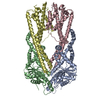
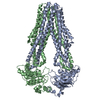
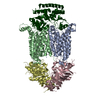



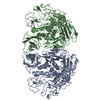


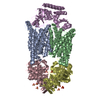
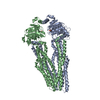
 PDBj
PDBj





